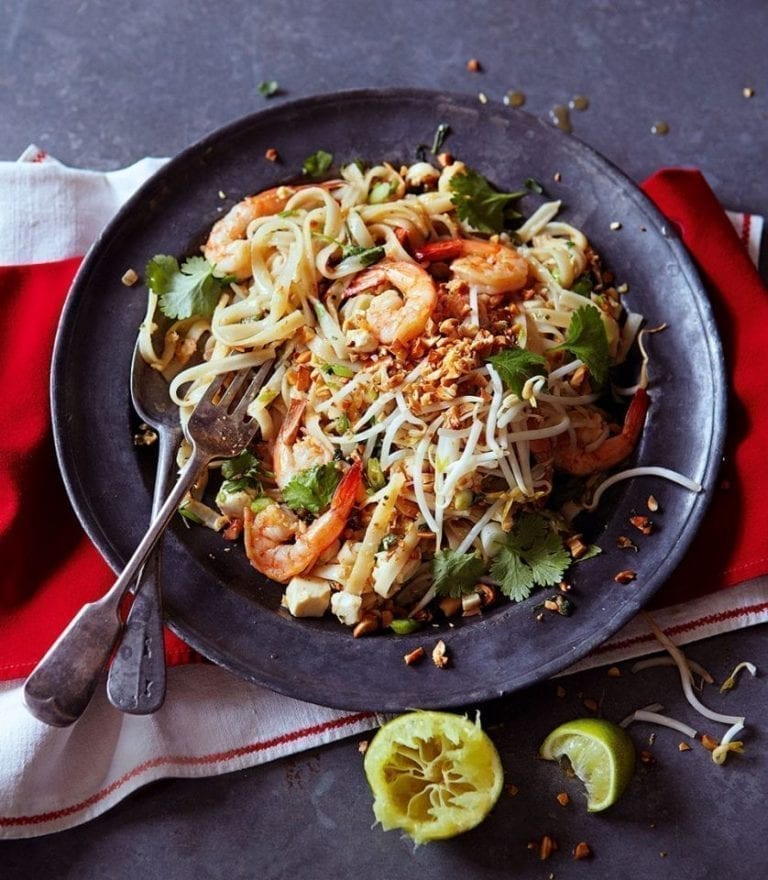
Quick pad Thai
- Published: 2 Nov 15
- Updated: 18 Mar 24
If you’re after a herby, nutty, zingy pad Thai that tastes and looks authentic, then this is the recipe for you. All it takes is 25 minutes to throw together!

Are you a fan of Thai food? Try this classic green chicken curry, warm satay salad and lots more Thai-inspired feasts.
Ingredients
- 300g flat rice noodles
- 80g shelled unsalted peanuts
- 1 large banana shallot
- 1 large garlic clove
- 200g sustainable raw peeled prawns
- 180g firm silken style tofu (see Know-how)
- ½ small bunch fresh chives
- 80g tamarind purée
- 70g soft palm sugar
- 70ml fish sauce (we like Thai Taste)
- Juice ½-1 lime, plus extra wedges
- 2 large free-range eggs
- 1 tsp light soy sauce
- Pinch hot chilli powder (optional)
- 4 spring onions, plus extra to serve
- Small bunch fresh coriander, plus extra to serve
- 1½ tbsp groundnut oil
- Handful ready-to-eat beansprouts
Method
- Put the noodles in a large bowl, then pour over plenty of cold water to cover and set aside while you prepare the rest of the ingredients. Put the peanuts in a small bowl. Finely chop the shallot and the garlic, then put them in another small bowl. Devein the prawns (see Know-how) and put in a bowl. Cut the tofu into cubes, then transfer to a small bowl and snip in the chives. Put the tamarind, palm sugar, fish sauce and lime juice in a saucepan. In a small bowl or jug, beat the eggs with the soy sauce and chilli powder (if using). Chop the spring onions and coriander and put in a bowl.
- Set the bowls of ingredients by the hob in the order you’ve prepped them. Put the saucepan with the tamarind mixture over a low heat and stir until the sugar has dissolved. Taste and adjust the seasoning. It should be salty, sour and sweet (it may need an extra squeeze of lime). Keep on a low heat.
- Bring a medium pan of water to the boil. Heat a large wok with 1 tbsp of the groundnut oil over a medium-high heat. Add the peanuts and cook, tossing regularly, for 2 minutes or until golden. Remove, keeping the oil in the pan, then finely chop or crush the peanuts in a pestle and mortar. Let the wok cool slightly while you do this.
- Meanwhile drop the noodles into the pan of boiling water and cook for 3-4 minutes until just tender. Drain in a colander, then rinse well with warm water.
- Return the wok to a low-medium heat and add the remaining oil. Stir-fry the shallot and garlic for 2-3 minutes until just soft but not golden. Increase the heat to medium-high, then add the prawns and cook for 2 minutes or until just pink. Add the tofu and chive mixture and cook for 1 minute. Add the egg and stir gently for 1 minute or until just set.
- Turn up the heat under the wok to high, then add the noodles along with the tamarind sauce and toss well. Add the spring onions, coriander and half the peanuts, then stir. Taste and season.
- Divide the pad Thai among 4 bowls and serve scattered with the remaining peanuts, the beansprouts and extra herbs and lime wedges.
- Recipe from September 2015 Issue
Nutrition
- Calories
- 478kcals
- Fat
- 19.2g (3.8g saturated)
- Protein
- 25.8g
- Carbohydrates
- 49.8g (17.5g sugars)
- Fibre
- 1.4g
- Salt
- 5.2g
delicious. tips
Some of these ingredients may sound unusual, but they’re all available from the world food section of large supermarkets.
To devein prawns, slit open the back as far as the intestinal tract with a sharp knife, then pull it out and discard.
There are many types of tofu, categorised according to the amount of water each one contains. The higher the water content, the softer the texture. For pad Thai, a firmer style is needed so it holds together under the high heat.
Buy ingredients online
Rate & review
Rate
Reviews
Subscribe to our magazine
Food stories, skills and tested recipes, straight to your door... Enjoy 5 issues for just £5 with our special introductory offer.
Subscribe
Unleash your inner chef
Looking for inspiration? Receive the latest recipes with our newsletter
